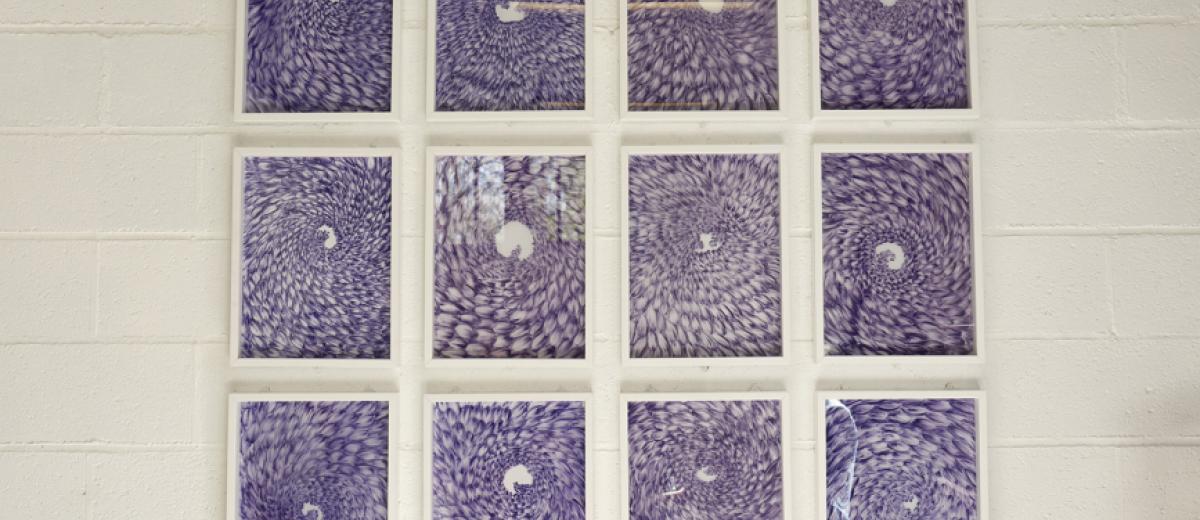J. Mâkhi Xenakis

"Thus they go across the boundless darkness…” warns Baudelaire in his poem “The Blind” (1857). Are we those same boundlessly blind when confronted with Mâkhi Xenakis’ pastels? There, where patient work with an eraser causes the tender milky darkness to spread across the white sheet of paper in unknown but palpable shapes. There, where boundless shades of fleshly pink hatch into smooth indefinite shapes on tracing paper suddenly filled to overflow. Xenakis’ pastels are bodies and places, tactile murmurings and organs of life covering the yawning void, the blind whiteness where what is absent has taken refuge, where silence has fled, where chaos is hiding. Her prolific series of pastels are voluptuous traps ensnaring our eyes and our doubts, gardens of delights for our most disquieting desires, where mineral tears espouse vegetable husks and animal flesh mates with floral tongue. Where marine alveoli call us down to the primal abyss, that of the birth of the self, that of the birth of the world. Our gaze is drawn in, widening at contact with the pastel’s sensuous texture, into its pulsations and retractions, into its inextinguishable density and shifting tensions, until it reaches a place pulsating with light, dimming all fear. There, in a pastel drawing, white is stripped bare, a whirlwind of life regained, a collar of light, a gaping oculus in the heart of a maelstrom of fleeting shadows and spawnings. These pastels are refuges of life…”. Marjorie Micucci.
"I write, I draw and I sculpt in regular autonomous fashion. These three means of expression have become essential to me. What cannot be expressed in one field may suddenly be expressed in another. There are no more moments of emptiness or silence. So many themes overlap and answer one another. When I start on a drawing or sculpture, I wait for that magical moment when, all of a sudden, something new and living makes its appearance, linked to our animality, our universality. I then experience the wondrously crazy sensation of creating life and keeping death a little at bay. The work is truly accomplished when I find the same feeling in whoever looks at it. For this invitation to Chaumont, I wanted to create a fresh correspondence between the blue sculptures that bid us welcome in the courtyard through new blue and violet pastels that lead us to the pink and black 'abysses'." Mâkhi Xenakis
BIOGRAPHICAL NOTES
Mâkhi XENAKIS
FRANCE

Born in Paris, where she lives and works. She divides her time between sculpture, drawing and writing. Her works figure in such public collections as the Centre Pompidou, the Manufacture de Sèvres, the Manufacture des Gobelins, FNAC and the FMAC in Paris. Her books are published by Actes Sud.
Among other places, her work has been exhibited at the Strasbourg Museum of Modern and Contemporary Art (MAMCS), the Orlando Museum of Art, the Museum of Hunting and Nature, the Maison Rouge, the Centre Pompidou, the Zadkine Museum, the Besançon, Brest and Nancy Museums of Fine Arts, and the Pitié Salpêtrière Hospital Chapel.
She has drawn and painted since she was a child. After passing a scientific baccalaureate, she studied architecture with Paul Virilio and created theatre sets and costumes, working with Claude Regy among others.
In 1987, award of a Villa Médicis external grant enabled her to move to New York, where she painted up until 1989, and where she met Louise Bourgeois – a decisive encounter. Following her return to Paris, she held regular exhibitions of her drawings. In 1998 she published “Louise Bourgeois, l’aveugle guidant l’aveugle” ("Louise Bourgeois, the Blind Leading the Blind"), a book in which she seeks out her subject’s childhood haunts and gradually reveals the secret links that formed between them and Louise Bourgeois’ body of work, immersing the reader in the complexities and mysteries of the creative process. In parallel, she produced her first sculptures, which she exhibited in Paris and Genevilliers in 1999, accompanied by the book “Parfois Seule” ("Sometimes Alone").
In 2004, after being invited to exhibit her sculptures at Salpêtrière hospital, a search through the Welfare Services Archives revealed the prison hell lived by thousands of women since the days of Louis XIV and she published “Les folles d’enfer de la Salpêtrière” ("The Madwomen of the Hell of Salpêtrière"). In parallel, she exhibited a series of 260 sculptures in the Salpêtrière Chapel.
In 2015, she published “Iannis Xenakis, un père bouleversant” ("Iannis Xenakis, an overwhelming father"), this time immersing us in the creative process behind her father’s work, making use of his personal musical and architectural archives.
A new, more intimate book on her relationship with Louise Bourgeois is being published by Actes Sud in 2017. The diversity of and connections to be seen in her sculptures and drawings, borne by the need to create life while maintaining a ration of anxiety, take on clearer meaning today in the light of her many books.